If you are a fresh video editor trying to get into the industry by showcasing your craft and talent, then you need the right PC – a PC that can be a reliable tool to help you achieve your editing and learning goals.
Of course, when starting, you may have budget constraints. Until you start making an income from your video editing craft, investing in a professional-grade desktop from the get-go is not wise, as the hardware can get quite expensive. Hence, this article is dedicated to building cheap desktops.
One of the core elements in choosing the right desktop for video editing is the CPU, particularly a CPU with a good multi-core performance.
Video rendering is perhaps one of the most signature tasks that tend to utilize a lot of cores.
Hence, when it comes to maximizing your budget for a video editing PC, you should always spend the most on a good CPU.
Besides that, RAM is also a critical component. Graphics Card is also important, but to a lesser extent – unless you want to explore hardware encoding.
In the text below, we will discuss how to buy the right video editing PC on a budget and the benchmarks to consider.
Jump Directly to PC Build RecommendationsWhat are Some of the Popular Video Editing Software?
It is important to take note of the popular video editing software since most buying guides use popular software for benchmarking the PC hardware.
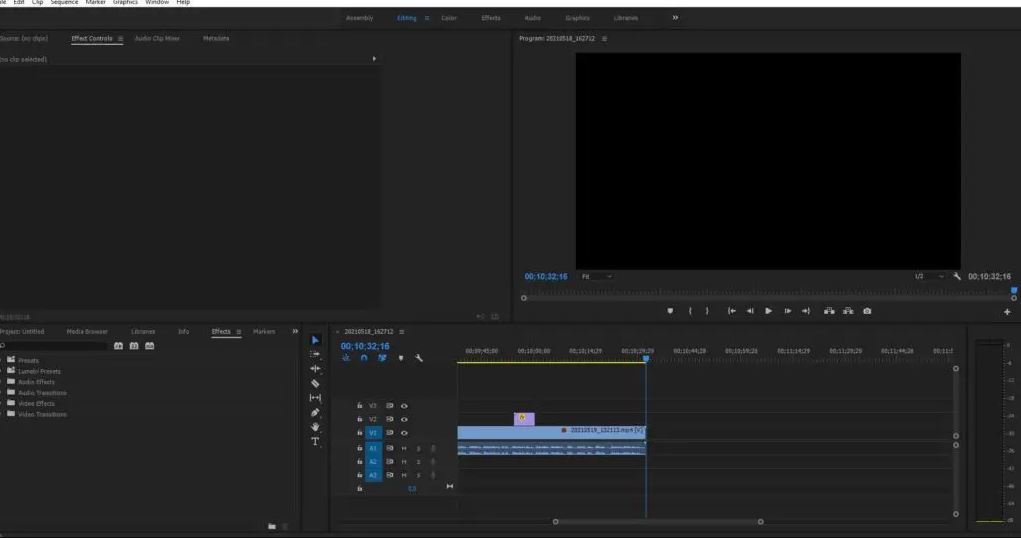
The software specifications in this list should give you an idea about the hardware requirement and the type of budget PC you should aim for.
This is not a complete list, as there are tons of other great video editing software out there, but the following should give you an idea:
- Adobe Premier Pro
- Davinci Resolve
- After Effects
- Sony Vegas
- Final Cut
These software have different pros and cons, and some specialize in one task over the other. For instance, Adobe Premiere Pro is excellent for editing and manipulating footage.
On the other hand, Adobe After Effects specializes in adding Visual Effects to your footage, creating digital motion and 2D animation.
This guide will mainly revolve around Adobe Premiere Pro.
TABLE OF CONTENTS
Spare a Sec for a Brief Poll
The following survey will help me improve the article and will only take you about half a sec to complete. : )
Build Guide for Budget Video Editing PC
What Kind of System and Hardware Do You Need for Video Editing?
As is the case with all work performed on a computer, the type of hardware you need for video editing depends entirely upon the level and size of your projects.
Suppose you are a beginner who is creating simple vlogs to be uploaded on YouTube occasionally. In that case, it naturally implies that your work doesn’t demand professional levels of video editing hardware that a film director would require.
You must understand how the video editing process works to make the right build for your system.
Let us go step by step here.
We will use Adobe Premiere Pro here, for instance.
Step 1: The Raw Video Footage is Saved on To Your PC from Your Camera
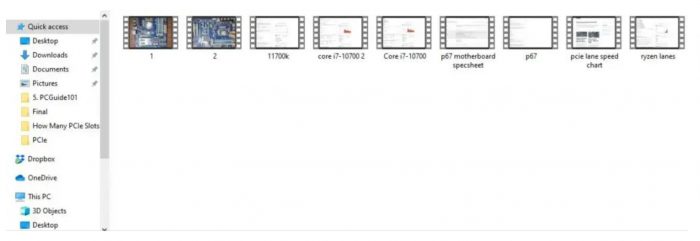
Image: Raw footage is loaded onto your PC
Immediately here in this task, you can see that the first component in question is the Hard Drive.
Of course, the CPU is doing all the work as far as carrying out the actual instructions are concerned, but here we are, looking at the different stages of your video footage and how the components fit in.
So the first component to look into here is your Hard Drive.
The faster your Hard Drive, the faster would be the process of loading and saving footage to and from your PC.
The Hard Drives for Budget Video Editing PC
There are two types of hard drives, i.e., spinning hard disk drives and SSD.
1. Hard Disk Drives – For Archiving Data
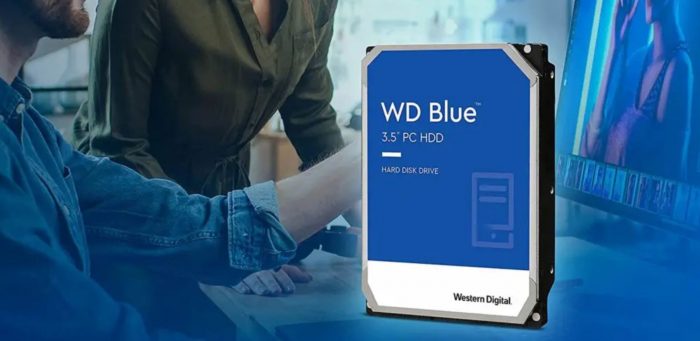
These large, bulky 3.5″ drives are cheap but very slow (Compared to an SSD).
The powerful Hard Disk Drives with 7200 RPM and a decent 256 MB cache have a transfer speed of only about 200 MB/s.
Every major brand, such as Seagate and WD, has different lines of Hard Disk drives. Each line specializes in a certain category.
For instance, WD Blue is a general-purpose hard disk drive. It has a slower transfer speed and a short warranty period. However, it is excellent for those on a budget.
WD Black, on the other hand, is a performance-grade hard disk suitable for gamers and video editors. But it is more expensive.
Generally, for video editing, the purpose of Hard Disk Drives is to save and archive media. While you can use them as your primary drive for “Hot Data,” we recommend you use SSDs for your work files instead.
What is Hot Data?
Basically, Hot Data is the video footage and media that you are currently working with at present.
2. Solid State Drives (SSD) – For Hot Data
SSDs are multiple folds faster than even the fastest hard disks out there. They are expensive but excellent for “hot data.”
We recommend having an SSD in your budget desktop for video editing, not just as your primary boot drive, but the video editing software should also be installed on an SSD.
In addition to that, all the files of the current project you are working on should be saved onto your SSD.
As far as the performance goes, the following is a short description of different types of SSD drives:
| SATA SSD | – These connect to SATA 3 interface – Have speeds of about 540 MB/s |
| 3rd Gen NVMe SSD | – They use the PCIe v3.0 interface. – Can reach read speeds of 3500 MB/s – Writes speeds of about 2700 MB/s |
| 4th Gen NVMe SSD | – They use the PCIe v4.0 interface. – Can reach read speeds of 7000MB/s – Writes speeds of about 5000 MB/s |
As you can see, the NVMe SSDs that use the PCIe interface are stupendously fast compared to a Hard Disk Drive.
However, you do have to note that you need the right processor and motherboard to support the 3rd or the 4th gen NVMe SSD.
For instance, to support the 4th Gen NVMe SSD like the Samsung 980 Pro, you need to have a motherboard and a CPU that conforms to the PCIe V4.0 protocol.
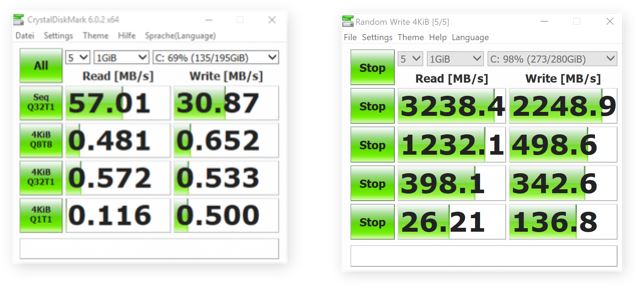
The bottom line is that the faster your hard drive is, the faster you can load and save files from your recording device to your PC.
SSDs are Expensive!
However, SSDs can get expensive. Therefore, depending on your constraints, SSDs may not be suitable for your budget video editing build.
Typically you can get a 2 TB hard disk drive for the same price as a 500 GB NVMe SSD. Hence SSDs are still about four times as expensive.
But in my opinion, $60 spent on a 500 GB SSD would provide you with a far better video editing experience than $60 spent on a 2TB HDD.
But, if you have a lot of data to store, then you can look into a high-performance hard disk drive instead, such as the WD Black.
Step 2: Loading the Footage onto Your Video Editing Software
The next step is to load or import your raw footage onto your video editing software.
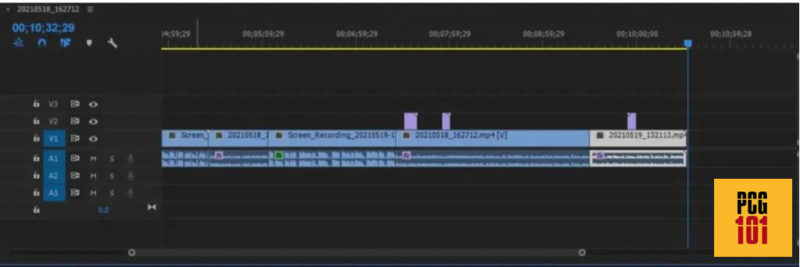
When you import your raw video footage into your software, it is loaded up from the Hard Drive and then decoded by the processor.
Once loaded and decoded, you can then edit and manipulate it using the software.
I have already covered the types of hard drives, and I have recommended SSDs for video editing. Now let us look into the CPU – one of the most integral components of your video editing PC.
Importance of CPU for Budget Video Editing PC Builds
CPU, being the most important component, should get the highest chunk of your overall budget.
Decoding the imported raw footage so that you can manipulate it in the software, actually performing the manipulation of video in the software, adding effects to your footage, and finally, encoding and rendering the footage all require a powerful CPU.
As a rule of thumb, the faster your CPU is, the better your overall video editing experience would be.
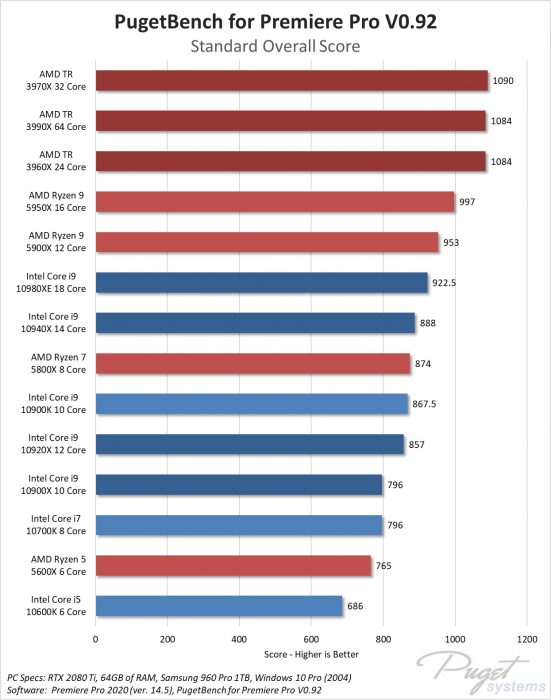
We can see here that the higher the single and multi-core CPU performance, the better the Adobe Premiere Pro performs.
Workstation-grade processors such as the Intel Core X series and the AMD Threadripper are clearly the winners, with 64 cores and 128 threads.
However, a workstation-grade CPU, just the CPU, can easily cost as much as an entire budget desktop for video editing!
For a budget build, you would rather be looking at the high-end Ryzen 3, Intel Core i5 / AMD Ryzen 5, and the Intel Core i7 / AMD Ryzen 7 series at most.
In fact, AMD Ryzen 7 and Intel Core i7 can push the financial limit of a budget PC for video editing.
Also Read: Intel Core i5 vs. i7 for Video Editing – Which is Better?
Live Playback vs. Rendering – CPU Single-Core vs. Multi-Core Performance
Adding effects to your video footage and its live playback in the workspace is primarily single-core.
To improve the actual experience of editing the footage in the software workspace, you should aim to get a processor with the best Single Core performance.
While playback and preview do utilize multiple cores, at the moment, you will not see any drastic benefit from a CPU with more than four cores (almost all CPUs have four cores these days).
On the other hand, exporting and rendering is a task that can significantly benefit from a good multi-core processor.
According to Adobe Premiere Pro specs:
8 cores are ideal for Premiere Pro. The application can use more cores, but without significant added benefit. Depending on the task, Premiere Pro runs at 93-98% efficiency with 8 cores.
The degree of efficiency you will see from a higher core count depends upon your codec and export settings.

For instance, when exporting 1080p footage using the H.264 codec, you will see benefits from a CPU that has up to ten cores. With anything higher than ten cores, you will not see any benefit.
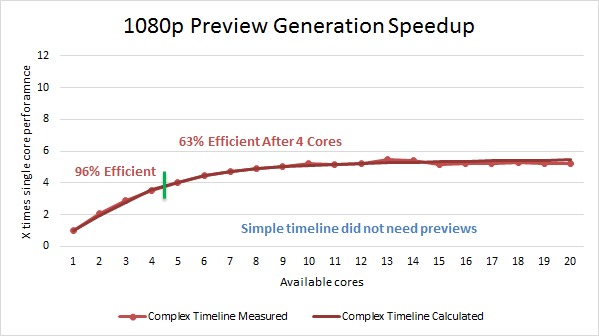
1080P Preview generation benefits the most from a 4-core processor. After four cores, you see some benefits up to eight, but anything beyond that is unnecessary.
Recommended CPU for Budget Video Editing PC
As mentioned earlier, for a budget video editing PC, you could be looking at the following CPUs:
- For Most Builds: A mainstream CPU from Ryzen 5 or Intel Core i5
- For Ultra-Budget Builds: A high-end AMD Ryzen 3 or Intel Core i3 processor
- For Semi-High Performance Builds: You could be pushing your budget here, but an AMD Ryzen 7 or an Intel Core i7 would be recommended.
With this said, we recommend the following affordable CPUs for your budget video editing PC build:
CPUs For an Ultra-Budget Build (<$150) With iGPU
The following CPUs have an integrated graphics card and hence are great for ultra-budget builds for video editing that will NOT feature a dedicated GPU.
| CPU | Specs | Cinebench R20 Score | CPU Passmark | iGPU G3D Mark |
| Intel Core i3 10100 ($122 MSRP) | 3.6-4.3 GHz 4 Cores 8 Threads 14 nm | Single-Core: 448 Multi-Core: 2284 | 8823 | Intel UHD 630 1396 |
| AMD Ryzen 5 3400G ($150 MSRP) | 3.7-4.2 GHz 4 Cores 8 Threads 12 nm | Single-Core: 412 Multi-Core: 1969 | 9369 | Vega 11 2141 |
Source:
The AMD Ryzen 5 3400G has powerful integrated graphics cards from Vega Series.
Hence, if you plan to ditch getting a dedicated graphics card and save up as much as possible with a decent performance, then we recommend this.
Intel Core i3-10100 is the cheapest CPU we can recommend. It features a weak CPU and GPU performance.
However, if you are just learning the ropes of video editing with small and simple projects, you can look into this.
Also Read: Is Integrated Graphics Card Good?
CPUs For an Entry Level Build (<$120) Without an iGPU
The following CPUs perform better but do not have an integrated GPU. Hence, these CPUs are great for those who plan to buy a dedicated GPU for their build.
| CPU | Specs | Cinebench R20 Score | CPU Passmark |
| AMD Ryzen 3 3100 ($99) | 3.6-3.9 GHz 4 Cores 8 Threads 7 nm | Single Core: 437 Multi-Core: 2351 | 11723 |
| AMD Ryzen 3 3300X ($120) | 3.8-4.3 GHz 4 Cores 8 Threads 7 nm | Single Core: 495 Multi-Core: 2588 | 12739 |
AMD Ryzen 3 3100 (MSRP $99) and the AMD Ryzen 3 3300X (MSRP $120) are the two most recommended CPUs, in our opinion, for a budget video editing build.
Regarding the sheer CPU performance, these two have the best performance/dollar value in the category.
CPUs For Budget Performance Build ($200-$300)
The next and final category of CPUs for budget video editing PC builds is those from the Core i5/Ryzen 5 CPUs.
The following are our recommendations:
| CPU | Specs | Cinebench R20 Score | CPU Passmark |
| AMD Ryzen 5 3600 ($199) | 3.6-4.2 GHz 6 Cores 12 Threads 7 nm | Single-Core: 472 Multi-Core: 3689 | 17865 |
| Intel Core i5 11600 ($220) | 2.8-4.8 GHz 6 Cores 12 Threads 14 nm | Single-Core: 495 Multi-Core: 2588 | 18074 |
| AMD Ryzen 5 5600X ($299) | 3.7-4.6 GHz 6 Cores 12 Threads 7 nm | Single-Core: 604 Multi-Core: 4562 | 22181 |
Depending upon how deep your pockets are, any of these CPUs, in my opinion, is great for budget Performance grade build for video editing.
The AMD Ryzen 5 3600 has a lower single-core score than the AMD Ryzen 3 3600X. However, its higher multi-core score makes it a great option for rendering and encoding tasks.
It should also be noted that AMD Ryzen 5 3600 and the Ryzen 5 5600X both are overclockable but do not feature an integrated GPU.
Here the Intel Core i5 11600 is the only CPU with an integrated Intel UHD 750 GPU. Hence, this is something you can look into for a build without any investment in a graphics card.
CPU for Video Editing Benchmark Summary
This is how the recommended CPUs stack up against each other. I have also included a few more CPUs here for reference.
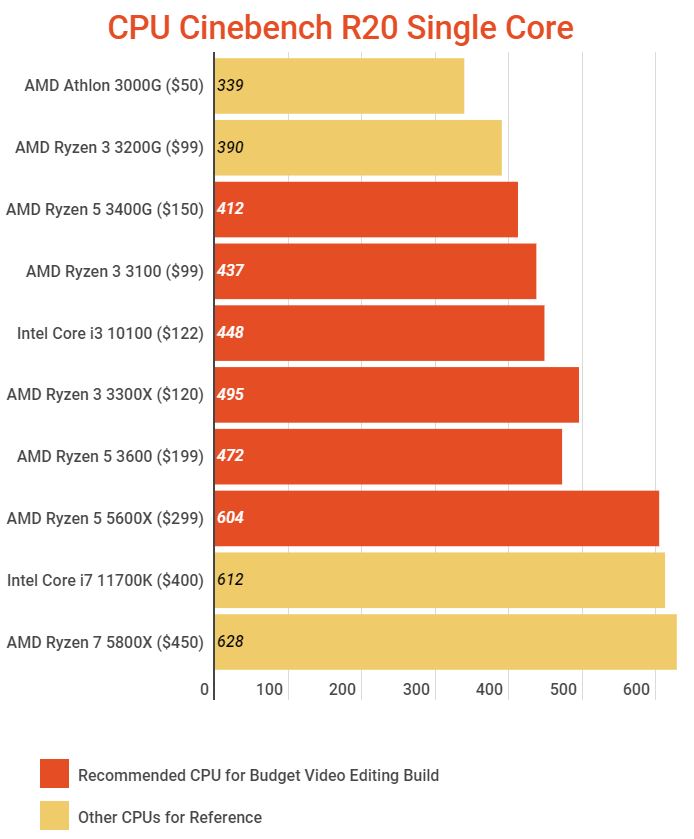
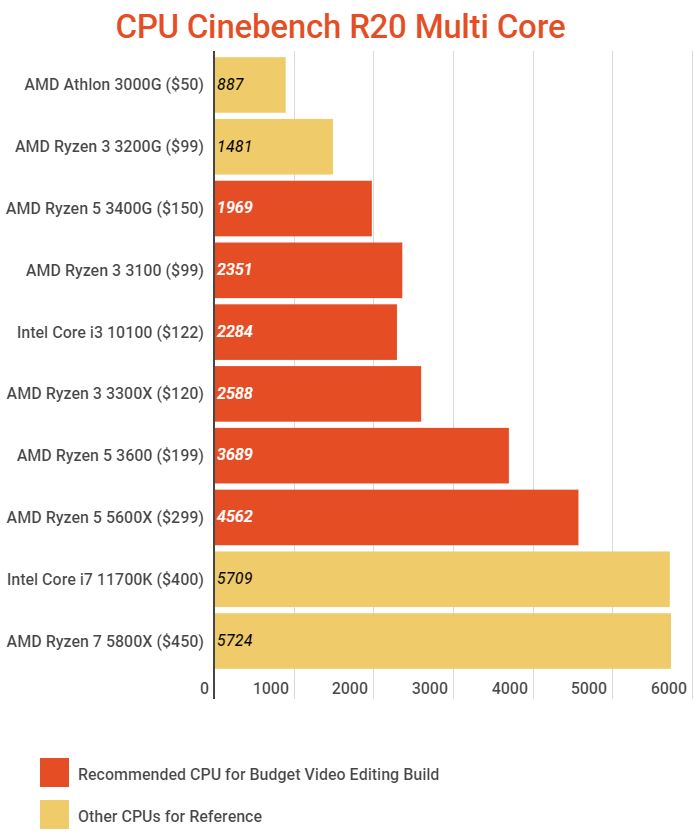
The following CPU mentioned have iGPUs
- Ryzen 3 3200G – Vega 8
- Ryzen 5 3400G – Vega 11
- Intel Core i3 10100 – UHD 630
- Intel Core i5 11600 – UHD 650
- Intel Core i7 11700K – UHD 750
This video has more information on the AMD Budget CPU segment:
Step 3: Video Editing, Manipulation, Adding Effects, Trimming
This here forms the bulk of your work. We are talking about the actual video editing process here.
We have already established here that the most important factor for your work in the actual software workspace, as far as the CPU is concerned, is its single-core performance.
However, this process uses another critical component, i.e., the RAM.
RAM for Video Editing
RAM is a storage that the video editing software uses for storing temporary video data.
All the actions that you perform in the workspace and when you playback in your timeline, your RAM will constantly be in use as the CPU decodes, encodes, and fetches all the calculations it performs.
Since these calculations are done very quickly, they cannot be stored in the Hard Drives, as doing so will create unbearable lags.
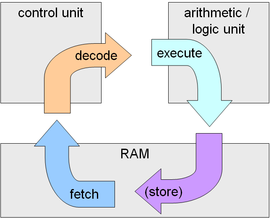
Image: This is a simplified Fetch-Decode-Execute-Store cycle of a processor. When manipulating footage in the software, your software constantly performs this cycle and stores a huge chunk of data in your RAM.
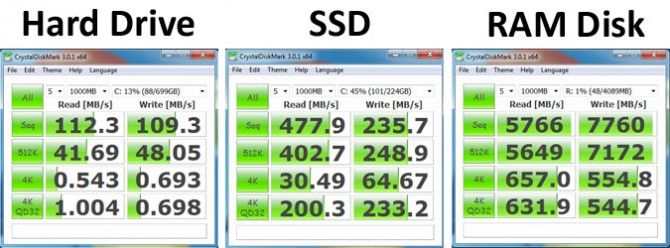
The reason why RAM is selected here is because it is the fastest storage for caching temporary data.
In addition to being fast, it also has the lowest latency; therefore, data can be stored and fetched instantly from RAM.
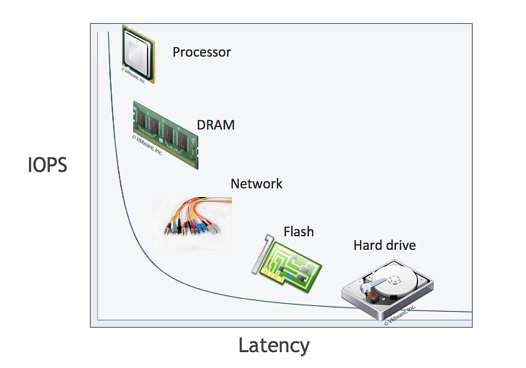
With RAM, the recommended amount to aim for is as follows:
- 8 GB – For very basic projects
- 16 GB – For intermediate use case.
- 32 GB – Recommended amount of professional 1080P video editing
- 64 GB – Recommended amount for professional 4K video editing.
For a budget build, we suggest a minimum of 8 GB of RAM and a recommended amount of 12-16 GB.
Step 4: Encoding, Rendering, and Storing
We have already briefly discussed encoding, rendering, and storing earlier.
Basically, the final high-level step in a typical video editing project is to render the video with a desired encoder.
Depending upon your choice of codec, export settings, and the resolution of your footage, you may or may not need a CPU with a high core count.
For instance, when using the popular H.264 codec for compression, 4-6 cores give you the best results for both 1080 and 4K videos. Anything higher than that, and the performance gains will reduce drastically.
Finally, the encoded and rendered video is saved onto your hard drive. Again, we recommend SSDs here.
How well your hard drive will perform will depend upon your encoding method. If you are using a very high bit rate codec for a 4K or an 8K video, for instance, you will need a fast enough hard drive and a large enough RAM to handle the huge video file being generated.
Where Does a Graphics Card Fit in for Video Editing?
Most video editing software, including Adobe Premiere Pro, are increasingly using the GPU for playback and encoding.
You don’t need a graphics card if you have a plain 2D video with little to no effects.
However, if you use GPU-accelerated effects, then you could see drastic improvements with graphics cards.
The GPU-accelerated effects in Adobe Premiere Pro are highlighted by a small icon next to them.

One point to note is that the performance gain you get from a midrange GPU compared to a high-end GPU isn’t too drastic.
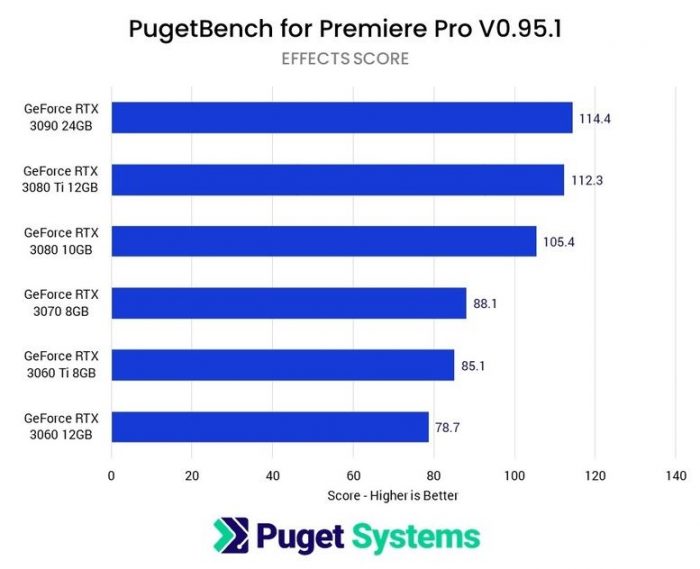
Again, the performance gains you notice will depend entirely upon how many GPU-accelerated effects you have.
Read in Detail: Do You Need a Graphics Card for Video Editing?
Hardware Based Encoding and GPU
Another important factor to point out is that if you use the H.264/H.265 codecs, you can now benefit from the GPU-based hardware encoding on Adobe Premiere Pro 14.2 or later.
You can see performance gains up to 5x, as detailed by PugetSystems, when using GPU-based hardware encoding when exporting to H.264/H.265.
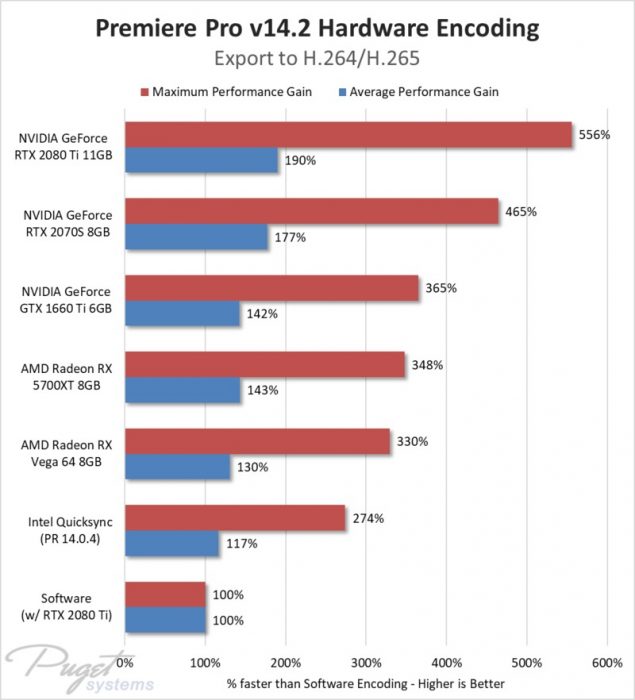
Should You Use Multiple GPUs?
No, the performance gains from using multiple GPUs are quite minimal – albeit Adobe Premiere Pro and many other video editing software support multi-GPU.
What About Quadro Graphics?
Quadro Graphics cards are workstation-grade GPUs. The only benefit they have over the GeForce or the Radeon graphics is the higher VRAM.
A higher VRAM amount is good for large-resolution workflows, such as working with 4k or 8k footage.
However, given their price, the cost/benefit ratio isn’t great compared to Geforce or Radeon cards, particularly for budget builds.
Like workstation CPUs, Nvidia Quadro graphics cards can cost as much or even more than a budget desktop for video editing.
The Right Motherboard for Video Editing
The choice of motherboard is simpler compared to a CPU.
Basically, you have to keep a price/performance parity between the CPU and the motherboard. You should not buy an expensive CPU and pair it with an entry-level motherboard.
A higher grade motherboard offers better VRMs and Phase Power Design to support more powerful CPUs, have more PCIe lanes, sockets ports, etc.
The following motherboard characteristics should be looked into when buying one.
Socket
This should match your CPU’s socket. For instance, if you plan to buy an AMD Ryzen 5 5600X, then you need a motherboard with an AM4 socket.
Chipset
There are different motherboard chipsets for low, mid, and high-end builds.
They differ in terms of how many PCIe lanes they have, how many ports and peripheral support they offer, whether they offer overclocking facility or not, how many GPUs they can support, what PCIE express version they support etc
Intel has the following popular chipsets
- B series i.e., B560 – For low-key builds
- H series i.e., H510 – For mid-range builds
- Z series, i.e., Z590 – For high-end builds – offers overclocking
AMD has the following popular chipsets
- A series i.e., A520 – For budget builds
- B series i.e., B550 – For mid-range builds
- X series i.e., X570 – For high-end builds
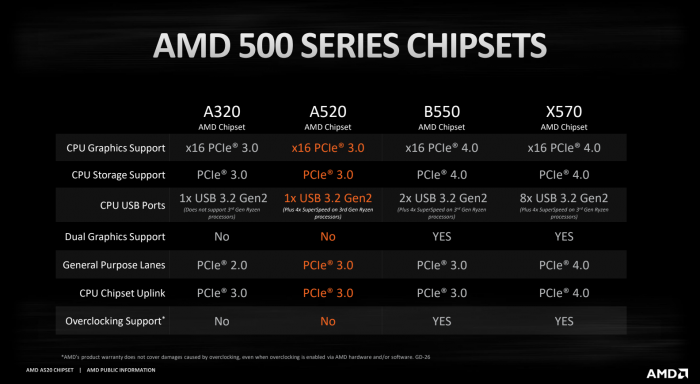
Also Read:
Ports and Slots
You must look into factors like how many SATA ports, M.2 slots and the PCIe express slots you need.
You also need to look at what kind of video out ports and peripheral connectivity ports you need, i.e., HDMI, Thunderbolt 3, USB 3.2 ports, etc.
What About the Good Old Monitor for Video Editing
The choice of a monitor and its configuration is a significant part of any video editing setup.
Multiple monitors, for instance, can greatly enhance your productivity.
Furthermore, professional monitors cover professional color spaces such as RGB and Adobe RGB and have a higher color bit depth allowing you to do justice to your art.
Some factors to consider when choosing a good monitor are:
Screen Size
We recommend at least a 24-inch monitor for a budget video editing build.
If you have a slightly higher budget for a display, I recommend investing in two 24-inch monitors rather than a single large 27-inch monitor.
This is because a wider display can improve your experience with manipulation inside the timeline.
Aspect Ratio for Editing Monitors
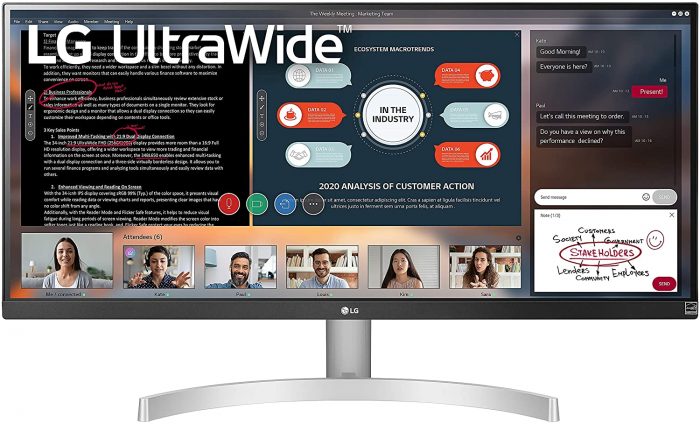
Another point to consider is the Aspect Ratio. Most monitors have a 16:9 aspect ratio. If you want an ultra-wide monitor, you can consider aspect ratios like 21:9 or 32:9.
The wider aspect ratio can give you a more comfortable experience with viewing and manipulating the timelines.
Unfortunately, ultrawide monitors are much more expensive than normal 16:9 widescreen monitors.
Resolution
As far as the resolution goes, that depends upon the size of the monitor.
Here is a general guideline for the screen size and its resolution.
- 24 inch: FHD 1920×1080
- 27 inch: WQHD 2560×1440
- 32 inch: 3K 3840 x 2160
Colors and Color Space
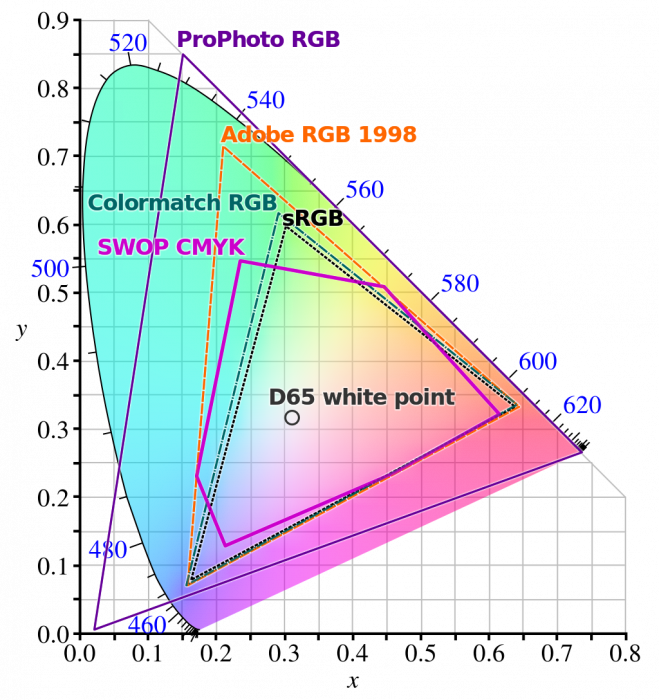
A few important things you can look into in a monitor are its color technology.
However, things such as a higher bit depth, color gamut coverage, local dimming, etc., can get VERY expensive and may not be suitable for a monitor intended for a budget video editing PC build.
- Color Gamut: at least sRGB color space; recommended is full coverage of Adobe RGB and DCI-P3
- Color Depth: The higher the color depth, the higher the number of colors that a monitor can show. 8-bit is quite common for IPS panels. If you have a higher budget, try to look for a display with 10-bit color depth.
- Factory Calibrated: To have minimal errors in the monitors’ colors, make sure it is factory calibrated with a Delta E of < 2.
- HDR: This feature can greatly enhance the monitor’s brightness, contrast ratio, and color gamut.
- Full Array Local Dimming: Found in top-of-the-line monitors. It can greatly enhance the contrast ratio.
Recommendations for Budget Desktops for Video Editing
There are two ways you can go about procuring a budget desktop for video editing:
- Go For the Custom build
- Get a Pre-built desktop
It does not matter what you choose if you get the proper hardware for the right amount.
Custom PC Build Recommendations
1. Ultra-Budget Video Editing PC Build ($450-$500)
| Component | Product | Product Description |
|---|---|---|
| CPU |  | AMD Ryzen 5 3400G 4 core / 8 Threads - Vega 11 Graphics |
| Motherboard |  | GIGABYTE B450M DS3H V2 - With AMD AM4 Socket - Micro ATX Form Factor |
| RAM | Corsair Vengeance LPX 8GB (1x8GB) - DDR4 2400MHz - C16 | |
| Storage |  | SAMSUNG 980 SSD - 500GB - M.2 NVMe - PCIe 3.0 |
| Power Supply Unit |  | EVGA 500W {100-W1-0500-KR} - 80+ White - NON MODULAR |
| Case |  | Cooler Master MasterBox MB600L - Mid Tower - Supports Upto ATX Motherboards |
Simply put, this is a build that can amply cater to you for light video editing work. If you are a beginner learning the ropes, you can check this system out. But if your work is a tad bit demanding; for instance, if you are a regular producer on YouTube, then you will need something beefier.
2. Recommended Budget Video Editing Build (Approx Cost ~ $1050)
| Component | Product | Product Description |
|---|---|---|
| CPU |  | AMD Ryzen 7 5800X 8 core / 16 Thread / 4.7 GHz |
| Motherboard |  | MSI MPG X570 GAMING PLUS - ATX - PCIe v4.0 |
| CPU Cooler |  | be quiet! Dark Rock 4 (BK021) - 200W TDP |
| GPU |  | ZOTAC GeForce GTX 1650 OC 4GB GDDR6 |
| RAM |  | Corsair Vengeance LPX 16GB (2x8GB) - DDR4 - 3200MHz - C16 |
| Storage |  | SAMSUNG 980 SSD - 500GB - M.2 NVMe - PCIe 3.0 |
| Power Supply |  | EVGA 600W {00-Ba-0600-K1 } - 80+ Bronze- NON MODULAR |
| Case |  | Cooler Master MasterBox MB600L - Mid Tower - Supports Upto ATX Motherboards |
Another highlight is that the CPU and the X570 motherboard here support PCIe 4.0 lanes. OPTIONAL: You also have the option to go for the cheaper B550 motherboards to save up further. I highly recommend the X570 as it offers PCIe v4.0 CPU AND chipset lanes. Plus, it offers better VRMs for overclocking.
I have also included a mid-range GPU here. I haven’t gone over the top with the graphics card since this isn’t supposed to be a premium gaming build. But the GTX 1650 Super should still perform quite decently on games. The GPU intends to provide support for the effects that require graphics acceleration. The MSRP or the release price of GTX 1650 is about $150.
Also, it is worth pointing out that the CPU does not have a stock cooling fan. I have recommended one here, but depending on whether you want to overclock or just use the stock speeds, you may or may not opt for a more powerful cooling solution.
Final Words
If you are serious about your video editing career or if you are just a hobbyist looking to test the waters with a video editing career, then you need the right tools to start with.
Having a good computer is the first step. Here we reviewed the ideal hardware specs that you should look for when building a video editing desktop.
If you need help with custom recommendations, please leave a message in the chat below.
More Gaming Build Guides
Frequently Asked Questions
1. What kind of storage should I use for a budget desktop for video editing?
For a budget desktop for video editing, we recommend using a combination of SSD and HDD storage. Use an SSD for the operating system and software, while using an HDD for storing your video files. A 250GB SSD is recommended for the operating system and software, while a 1TB or larger HDD is recommended for video file storage.
2. What graphics card should I use for a budget desktop for video editing?
When building a budget desktop for video editing, we recommend using an NVIDIA graphics card, preferably from the GTX or RTX series. An NVIDIA GTX 1660 or RTX 2060 graphics card should be sufficient for basic video editing tasks.
3. What kind of monitor should I use with a budget desktop for video editing?
When building a budget desktop for video editing, we recommend using a monitor with a resolution of at least 1080p and a refresh rate of at least 60Hz. A larger monitor size will also help with video editing. We recommend a 24-27 inch monitor for video editing on a budget.
4. Can I use a laptop for video editing instead of a desktop?
While a desktop is preferred for video editing, a laptop can also be used if it meets the minimum hardware requirements for video editing. However, keep in mind that laptops are typically more expensive than desktops with similar specifications. Laptops may also have limited upgradability and cooling, which can affect their performance during long video editing sessions.

It was interesting reading. Thank you!
Glad you liked it!
Very effective information. Thanks!
Having read the entire piece (and a couple of links) -and I scrolled here! – I enjoyed your effort at presenting a solid understanding of what to look for through the level of detail needed to decipher the options on the market today.
Thanks. I am glad you liked it.
Im thinking of purchasing the HP with Ryzen 7 4700G. Will it work for smooth editing 1080p without dedicated gpu?
In most cases, it should suffice. But again, it all depends upon the complexity of the project you are working on.
Very well done! Great information on each computer component and hardware. I believe there are many of us who are just looking for a great PC that can be used for a desktop computing…..Video editing and a few great video games. Without the cost of needing to rob a bank. lol